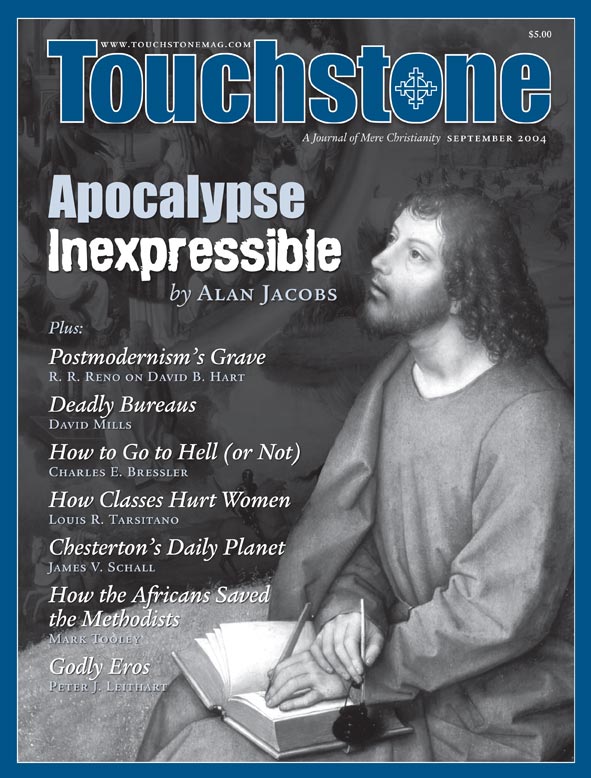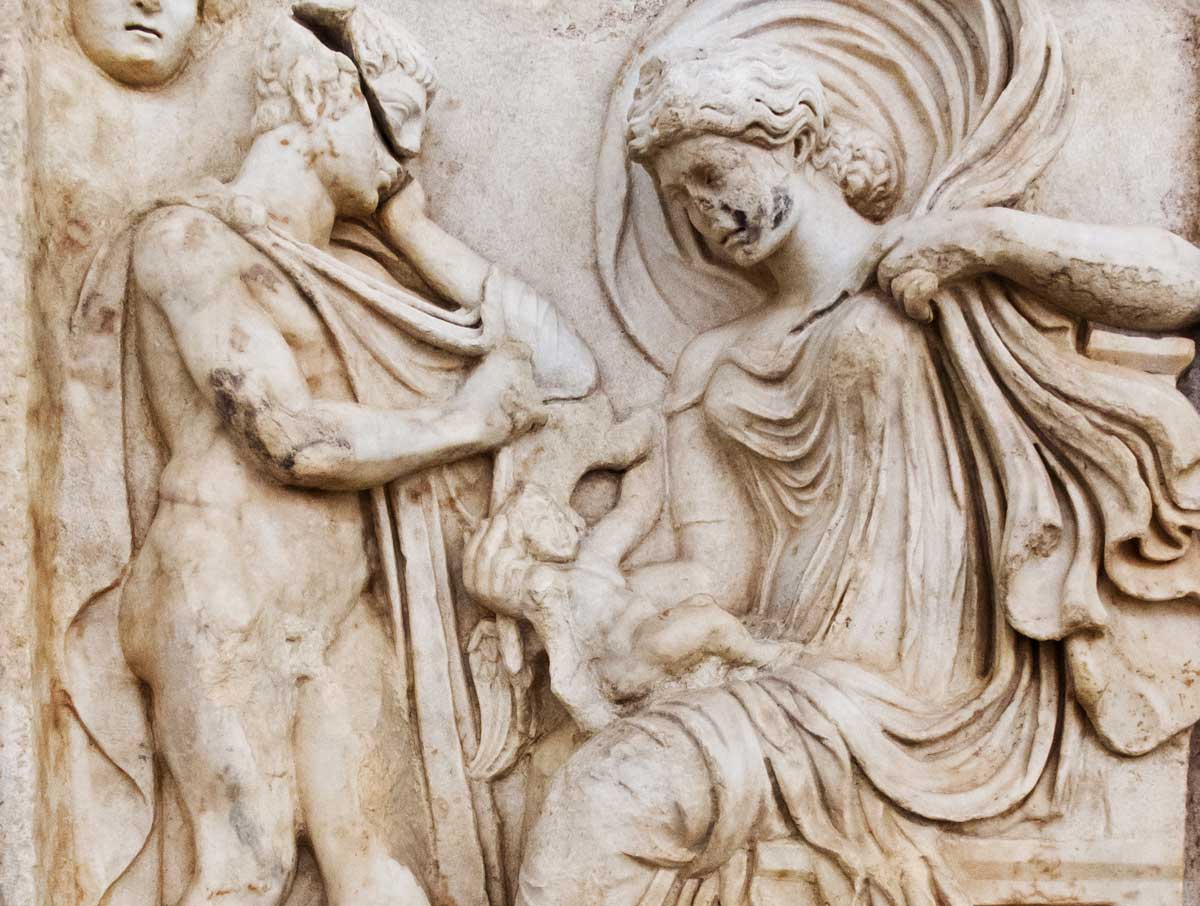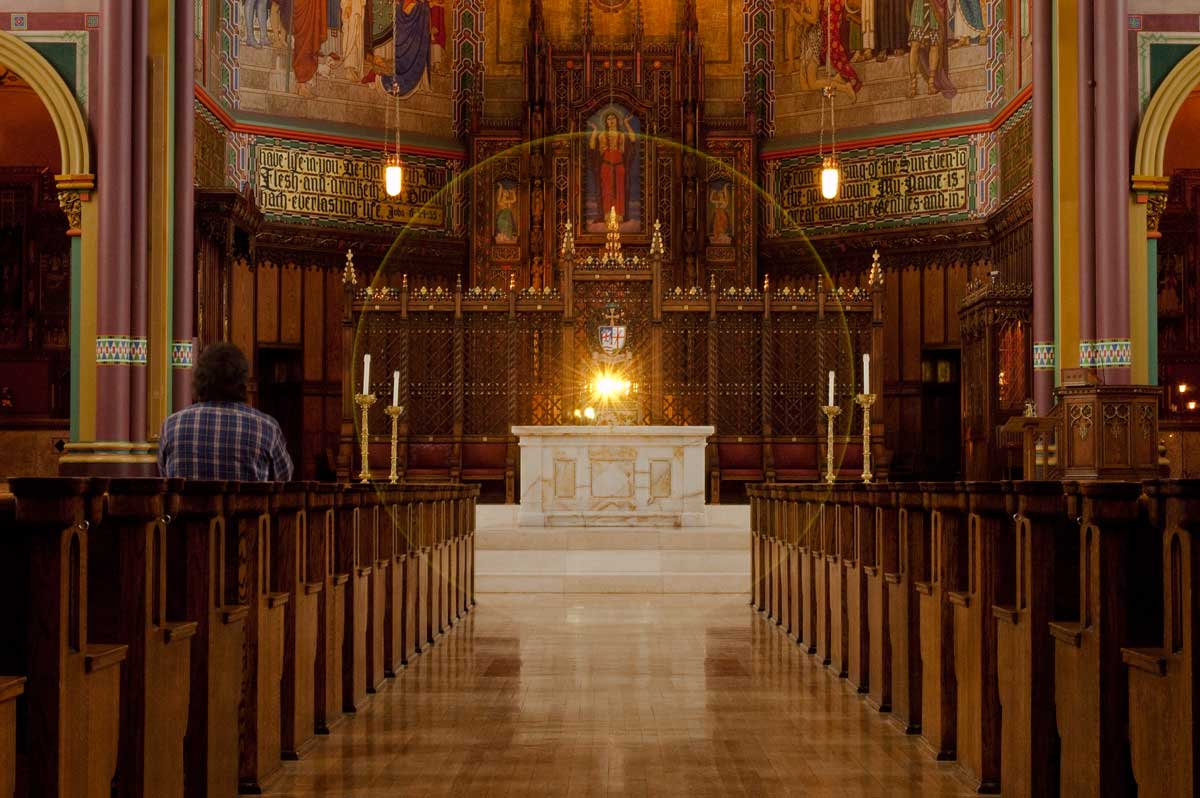Return to Beauty
The Beauty of the Infinite: the Aesthetics of Christian Truth
by David Bentley Hart
Eerdmans, 2003
(460 pages; $55.00, hardcover)
reviewed by R. R. Reno
Some decades ago the novelist Malcolm Cowley observed that literary culture tends to shift and change in thirty-year, generational stages, an insight that surely applies beyond the realm of literature. One need not be a brilliant social critic to observe that the last three decades have been relentlessly and homogeneously “post-sixties.”
Gore Vidal still writes diatribes. David Horowitz still inveighs against tenured radicals. Undergraduates still read Jacques Derrida and Michel Foucault. Book catalogues burst with new titles, but the assumptions, themes, and rhetoric are anything but new. By a thirty-year reckoning, American intellectual life is creakingly old—perhaps even dead and worm-ridden.
It is with this sense of generational superannuation that one should approach David Hart’s remarkable book, The Beauty of the Infinite. Hart’s command of postmodern literary and philosophical discourse, the idiom with which the sixties generation of scholars and intellectuals have clothed themselves in recent decades, is complete. Any young student who is about to begin doctoral studies in comparative literature or gender studies or some other fashionable topic will immediately recognize in Hart an intellect quite capable of the gymnastics of “difference,” the high mysteries of “alterity,” the incantations of “otherness.”
But more importantly, that young student will find in the Orthodox Hart the voice of one summing up the efforts of the post-sixties generation and passing judgment. The verdict is clear and forceful: The world of contemporary “humanistic” study is not humane at all. The languid, ironical intellectual class that came of age in the 1960s is like a flock of vultures circling around a nihilistic, violent, ugly, anti-human conclusion.
The generations are changing. The post-sixties baby boomers entertain Viagra-induced illusions of perpetual potency, but they cannot medicate themselves to immortality, and David Hart has not come to praise them, but to bury them.
Secular Theology
Hart shovels furiously. The Beauty of the Infinite is a veritable Himalaya of prose. Sentences run to great lengths. Paragraphs straddle pages. Technical philosophical and theological vocabularies abound and compound into poetic refrains. The diagnosis of contemporary intellectual life that Hart develops and the case he wishes to make for the surpassing beauty of the Christian witness are important and complex, and he does not spare his readers. Nonetheless, the structure of the book is straightforward, and the basic argument admits of intelligent summary.
Part One provides a detailed exposition of the dominant worldview of contemporary intellectuals, what Hart calls the “secular theology” of the post-Christian West. In Theology and Social Theory, a seminal work of the last decade, John Milbank outlined this secular theology. Hart draws on his analysis, arguing that we live in an age animated by a pessimistic, anti-metaphysical vision of reality. All order, form, and enduring substance are seen as forged by a primal and continuing violence. As Hart observes, for the dominant intellectuals of postmodern Western culture, “every discourse is reducible to a strategy of power, and every rhetorical transaction to an instance of an original violence.”
To use Hart’s favored characterization, our age functions according to an “aesthetic of the sublime.” In the early modern period, philosophers were keen to distinguish between two kinds of aesthetic experience. The beautiful, they theorized, affects us through order, harmony, and proportion. The sublime, in contrast, affects us through its inscrutable and overwhelming power.
For example, Wordsworth describes the glaciers and cascades of the Alps as transfixing in their chaotic images and superhuman scale. These vistas chilled him, while the ordered landscapes and human habitation of his beloved Lake District warmed his heart. The crashing avalanches of ice were sublime; the elderly shepherd with his sheep against the background of Gothic ruins was beautiful.
One of Hart’s contributions to the Christian diagnosis of postmodernity is his application of this aesthetic distinction to our metaphysical intuitions. For postmoderns, things are frozen and fixed by an overpowering, overawing potency, and we imagine that our only hope for freedom is either to slink away from the presiding presences of naked power (the authoritarian state, the cold impersonal judgments of traditional morality, the ancient myths of truth) or to resist with the equal and opposite violence of denunciation and rebellion (the sans-culottes storming the Bastille, sixties revolutionaries screaming invective, Karen Finley smearing herself with chocolate). In both cases our moral and political imaginations are shaped by an aesthetic of the sublime.
Hart develops this account of contemporary intellectual culture through close readings of such priests and clerks of the post-Christian West as Martin Heidegger, Gilles Deleuze, Emmanuel Levinas, Jean-François Lyotard, and Jacques Derrida. However, the crucial figure in Hart’s account is Nietzsche. From this great prophet of our time, Hart draws two important categories, the Dionysian and the Apollonian, to outline the spiritual and intellectual economy of postmodern thought.
Nietzsche’s Project
For Nietzsche, the Dionysian signifies the vital and reckless realm of free desire, play, and revelry. The Dionysian is, in the patois contemporary academics use to title their books and articles, “difference” or simply “the Other.” It is the chaotic demand of irreducible individuality, the feeling we have when desire wells up within us and demands expression and fulfillment, whatever the cost. By Nietzsche’s reckoning, the history of Western thought and religion is the story of our efforts to bring order and purpose to the Dionysian impulse. The Apollonian describes this effort. It is the form of reason and justice that we use to discipline and constrain the Dionysian.
Hart’s reading of Nietzsche is subtle and definitive, one of the finest discussions of Nietzsche’s spiritual-aesthetic project currently available. The crucial point for Nietzsche is that Western culture, and especially Christianity, has developed an elaborate and deceptive lie to justify the triumph of order and form (the Apollonian) over the playful and reckless (the Dionysian). We imagine that order and form offer a discipline that fulfills our humanity, but Nietzsche argues (or more accurately, insinuates again and again) that this is not true.
The Apollonian can only overawe and repress the vital forces of life; it can only bottle up and imprison the Dionysian, terrifying and controlling the Dionysian just as the glaciers of the Alps froze Wordsworth with an anxious awe. Thus, for Nietzsche, the economy of all intellectual, moral, and theological thought and practice is agonistic. “There is,” writes Hart, “in the Nietzschean cosmos, a perpetual violence [the repressive Apollonian] against violence [the devil-may-care Dionysian].” Our only choice is which side to take—or so Nietzsche says.
Nietzsche pictures reality within an aesthetic of the sublime. The same aesthetic dominates contemporary intellectual culture. Consider a current controversial issue such as homosexual marriage. Nearly all contemporary pundits treat sexual desire as the Dionysian and the constraining, shaping force of marriage as Apollonian. For the postmodern gurus and their epigones, then, it is transparently clear that traditional ideas such as heterosexuality, monogamy, and chastity can only restrain sexual desire by threat, intimidation, and most of all, by controlling desire with the full force of invented categories of “right” and “wrong.”
By this account, reason and righteousness are nothing more than the mechanical huffings and puffings of the machine controlled by the Wizard of Oz. Our individuality in all its sensuous, spontaneous particularity is given order and form by the aggressive, loud, monarchical voice of an ultimately artificial and arbitrary power. Such are the dynamics of the sublime. The mountains of traditional morality tower over us, and we feel small and vulnerable.
This postmodern view of life dominates our culture. Our cultural assumption is that freedom and personal fulfillment come only when we resist the aggressions of the Apollonian, only when we tear away the screen that hides the wizards of cultural repression and reveal their hypocrisy, mendacity, and pettiness. There is always a “subtext” (to use a ubiquitous critical flourish) to be revealed, and a great deal of contemporary academic life is little more than a perpetual game of “gotcha” as we fence to see who is “unmasked” first. Such is the final fruit of the so-called Decade of Love.
Hart’s analysis of the postmodern descent into the inferno of perpetual critique is a tour de force. Milbank’s Theology and Social Theory provides a richer and fuller genealogy of the postmodern project, but Hart enters more completely into the spiritual atmosphere of postmodernity. Thus, certain favorites of theologians in search of contemporary patrons are well analyzed. Hart’s account of Emmanuel Levinas, often read as an alternative to postmodern nihilism, is devastatingly persuasive. His discussion of the postmodern Christian castrati such as John Caputo and Gianni Vattimo is deliciously judgmental.
Hart is not one for half-measures and careful negotiations. He wishes to sweep away a generation’s discredited ideas. His preemptory tone, which any reader will immediately recognize, reflects an exasperation with the vain attempts to stage-manage the logic of post-Christian Western philosophy toward something vaguely humanistic, or worse, to arrange a shotgun marriage with Christianity.
Christian Beauty
The great strength of The Beauty of the Infinite, however, is not to be found in the unmasking of the unmaskers (and of the cosmeticians who are forever trying to soften the mask of death). The lasting influence of the book stems from the degree to which Hart limits his discussion of error.
The devil has his say, but Part Two constitutes the bulk of the book, and it is devoted to an analysis of the distinctive, peaceful sensibility woven into the very fabric of Christian metaphysics. Structurally, then, Hart avoids the very modern and postmodern sensibility he decries: the love of demolition, the lust for denuding received forms, stripping them bare, and displaying the ugliness of their error. Slightly more than one hundred pages are devoted to critique; nearly three hundred pages are dedicated to a patient evocation of the aesthetic of beauty that flows from the very identity of the Christian God.
In these pages Hart far outdistances his friend and predecessor John Milbank and other thinkers who wish us to turn away from the modern and postmodern project but do not provide a convincing alternative. Too often, those most skilled in diagnosing postmodern “secular theology” seem to find their spiritual imaginations crimped by the errors they hope to reject. Not so Hart. He has a remarkable ability to draw out the metaphysical intuitions at work in our age, but his own sensibilities remain scrupulously anachronistic. He draws on the church fathers rather than trying to add epicycles to the basic moves of postmodern discourse.
This escape from the postmodern aesthetic of the sublime is important. For the generations will not change and young students will not escape from the death-grip of academic postmodernism until a confident, articulate, and winsome voice can speak an alternative. Hart does, and as one reads, one feels the wheels of intellectual culture turn.
The Alternative
What, then, is Hart’s account of the Christian alternative? The conceptual key is theological and Trinitarian. By retuning to the great figures of patristic theology, Hart shows how the church fathers answered the deepest metaphysical questions about the source and order of all things by recourse to the God whose identity is revealed in the life, death, and resurrection of Jesus Christ.
For the Fathers, God is utterly other as source and end of all things, and yet, in Jesus Christ, God is present and participant within the particularity and history of reality. God does not overawe at a distance. God is not the remote One whose identity imposes unity upon the diversity of the creation. Rather, God is the Father, the Son, and the Holy Spirit, a singular divine life whose distance within itself provides room and scope for the eternal harmonies of love.
For this reason the church fathers could think about the creation of the world, its discipline under divine governance, and its consummation in Jesus Christ, as something other than a story of Dionysian dispersion followed by the repressive imposition of the Apollonian. Christianity, as Hart explains, has an aesthetic of beauty and a peaceful hope. The Trinity is not a mystery in the sense that distant, awesome, and towering mountain heights are remote and inaccessible. The mystery of the divine life is to be found in the intimacy, accessibility, and love of God. The shepherd knows his sheep.
Because God simply is the Triune life, there is a place for the infinite particularity of beings within the restoration, divinization, and completion that is accomplished by and in God. Within his house there are many mansions. There is a place for all the surging stuff of life—a place for us—within the life of God, because, as Hart writes, “the entire motion of condescension—creation, covenant, incarnation—is already contained in the perichoretic motion of the Trinity.”
Thus, we can conform our selves, our minds, and our desires to the original source and final end of all things (which is, after all, the basic spiritual project of metaphysics) without fear of enslavement, absorption, or destruction. We can seek the face of God confident that the disciplines and renunciations necessary for the journey will perfect, order, and harmonize our humanity and individuality. To return to Hart’s basic categories, in Christ we are not overpowered by God as a sublime truth; we are romanced by God as pure beauty.
Hart’s Success
Well, I have fallen into a poetical mode. Rather than imagining this a failure in describing Hart’s analysis of the logic of the classical Christian tradition, perhaps it is an indication of his success. Hart recognizes that one cannot demonstrate or prove the truth of Christ. He discusses current debates about divine apathia (making a convincing case for patristic usages) and the doctrine of analogy (which he helpfully situates in the larger context of the divine economy at work in all things). He dissects French post-structuralist phenomenologies of the gift and digresses into a defense of Anselm’s Cur Deus homo.
In each instance, Hart’s subtle command of the patristic sources provides readers with reliable guidance through a range of dogmatic topics. His ressourcement is not a restoration of patristic theology as a mummified discourse. Instead, the precision and depth of his criticisms of postmodern thought free the ambient metaphysical vocabulary of our time for theological use. Thus, Hart often draws on the pervasive textual metaphors of postmodern discourse, speaking of “gift,” “intensity of surfaces,” “pedagogy of parataxis,” and “narratives of infinity.”
These terms (and many others—Hart is promiscuously inventive) may be alien to traditionally minded theologians, but in Hart’s use they are given content and controlled by the gospel. The vocabulary may be postmodern, but the grammar is Cappadocian through and through. In this way, the rhetoric of The Beauty of the Infinite enacts what it seeks to commend. Hart romances his readers; he does not try to overawe them with dialectic.
Will our age allow itself to be romanced? I leave this question to the prophets. However, of one thing I am sure: As Cowley’s thirty-year scheme predicts, we are at a cultural turning point. Consider this example picked at random from The Beauty of the Infinite. When discussing the postmodern myth that Western culture privileges speech over writing—the contemporary, high scholastic way of saying that inherited Christian forms of life are authoritarian and oppressive—Hart makes the following observation about Jacques Derrida’s treatment of classical Christian figures such as John Chrysostom: “He does not pay a moment’s attention to what theology says, but simply imposes upon it his tidy set of binary opposition.”
The assessment is immediately and crushingly true, not only of Derrida, but of his generation. Aging postmodern intellectuals do not read texts, nor do they attend to the subtle, nuanced textures of life. They use texts as occasions for what they imagine to be “liberative reading practices.” All recalcitrant particularity is overawed by the sublime truths of Theory.
Like the anxious Aztecs whose captives were ritually sacrificed to keep the sun on it course, countless literary professors are at their lecterns offering up the hearts of great poems, novels, and plays to keep their theoretical commitments alive. Worse still, theologians scavenge through the wreckage of the vivisected texts, trying to construct a postmodern theology. The ugliness of it all is depressing.
A Christian Future
Hart’s approach and his patristic theology expounded in postmodern idioms may not satisfy all readers.
For the cooler intellects, Bruce Marshall’s Trinity and Truth, a seminal study of some of the same themes, may provide a more satisfactory account. For those who wish for a genealogy of our current situation, Ephraim Radner’s monumental study of post-Reformation Christendom and its collapse, The End of the Church, is indispensable. Each differs in style and emphasis, but together they and others (one thinks of the growing ranks of Stanley Hauerwas’s students and generational heretics such as Robert Jenson) have begun to articulate a future for younger Christian intellectuals, a future that disentangles us from the dead-ends and delusions of contemporary Western intellectual culture.
The post-sixties generation may have the endowed chairs, but they are intellectually moribund. The generations are changing. Hart provides us with a particularly clear view of the terrain and the options before us. Let us not hesitate to move forward, remembering that, as C. S. Lewis once said, when you are going in the wrong direction, the shortest route to the right one is to turn around and go back the way you came.
R. R. Reno teaches theology and ethics at Creighton University in Omaha, Nebraska, and is author of In the Ruins of the Church: Sustaining Faith in an Age of Diminished Christianity (Brazos, 2002).
subscription options
Order
Print/Online Subscription

Get six issues (one year) of Touchstone PLUS full online access including pdf downloads for only $39.95. That's only $3.34 per month!
Order
Online Only
Subscription

Get a one-year full-access subscription to the Touchstone online archives for only $19.95. That's only $1.66 per month!
bulk subscriptions
Order Touchstone subscriptions in bulk and save $10 per sub! Each subscription includes 6 issues of Touchstone plus full online access to touchstonemag.com—including archives, videos, and pdf downloads of recent issues for only $29.95 each! Great for churches or study groups.
Transactions will be processed on a secure server.
more from the online archives
calling all readers
Please Donate
"There are magazines worth reading but few worth saving . . . Touchstone is just such a magazine."
—Alice von Hildebrand
"Here we do not concede one square millimeter of territory to falsehood, folly, contemporary sentimentality, or fashion. We speak the truth, and let God be our judge. . . . Touchstone is the one committedly Christian conservative journal."
—Anthony Esolen, Touchstone senior editor









